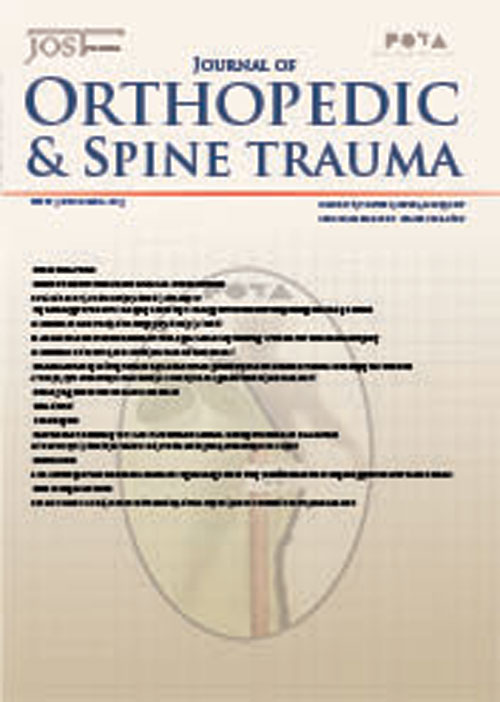فهرست مطالب

Journal of Orthopedic and Spine Trauma
Volume:4 Issue: 1, Mar 2018
- تاریخ انتشار: 1397/01/25
- تعداد عناوین: 5
-
-
Page 2BackgroundRevision total hip arthroplasty (RTHA) is one of the critical topics in the orthopedic surgery. In this single center case series, the revision treatment of cases with acetabular defects following total hip arthroplasty is reported.MethodsA total of 25 patients with acetabular defects were enrolled in this case series held in Imam Hossein Hospital, Tehran, Iran. The mean follow-up of patients was three years (24 - 42 months). The illustrated data include a history of surgeries, underlying diseases, acetabular defect classification, surgery procedure, and pre- and post-surgery complications and managements, Harris hip score (HHS), leg length discrepancy (LLD).ResultsThe mean age of patients was 63.8 ± 10.45 years. A total of 14 patients had two previous surgeries, eight patients had three surgeries, and three patients had four previous surgeries. Classification of bone loss using AAOS showed that four patients had grade III and 21 patients had grade IV acetabular bone loss. The RTHA was done using anti-protrusio in 12 patients and large cups in 13 patients. The mean Harris hip score was 22.16 before RTHA, which was 80.6 after revision surgery. Before the operation, the mean leg length discrepancy was 38.84 mm, which was corrected after surgery to an average of 3.56 mm.ConclusionsExtensive evaluation of patients with acetabular defects before and during revision surgery leads to promising results. Larger studies evaluating the management strategy in patients with acetabular defects are needed.Keywords: Revision Total Hip Arthroplasty, Acetabular Defects, Anti-Protrusio Cage, Complication
-
Page 3BackgroundPatellar resurfacing in total knee arthroplasty (TKA) is a matter of long-standing debate and there is no consensus regarding the superiority of either patellar resurfacing or patellar nonresurfacing.ObjectivesWe aimed to compare the outcomes of patellar resurfacing with patellar nonresurfacing in a cohort of knee OA patients sustaining a TKA.MethodsIn this retrospective study, patients who had undergone TKA between 2001 and 2011 in two hospitals in Tehran, Iran, were included. The Persian version of Western Ontario and McMaster Universities Osteoarthritis Index (WOMAC) was used to quantify the health status of patients. Post-operative complications and rate of reoperation were also compared between the two study groups.ResultsThe study population consisted of 89 patients in the resurfacing and 72 patients in the nonresurfacing groups. The demographic characteristics of the patients were not significantly different. The mean total WOMAC scores were 19.1 ± 8.8 and 19.6 ± 9.7 for the resurfacing and nonresurfacing groups (P = 0.55). No significant difference was observed between the mean WOMAC subscale scores of the two study groups including pain (P = 0.73), stiffness (P = 0.24), and physical function (P = 0.84). Two reoperations (2.2%) were performed in the resurfacing group and one (1.4%) in the nonresurfacing group.ConclusionsThe health status and rate of reoperation were not considerably different between the patellar resurfacing and nonresurfacing groups. These results reveal that patellar resurfacing is not necessary in TKA.Keywords: Patellar Resurfacing, Patellar Nonresurfacing, Total Knee Arthroplasty
-
Page 4IntroductionPrimary bone hydatidosis is a rare disease. The clinical manifestations of bone hydatidosis are confusing. Musculoskeletal involvement in hydatid cyst may be misdiagnosed as bone tumor. Although bone hydatidosis is not very common, timely diagnosis and treatment of this disease is important for preventing serious complications.Case PresentationThis study reports on a 37-year-old woman with primary bone hydatidosis of distal femur and secondary involvement of the knee joint. The patient was treated with arthroscopic irrigation and debridement and open curettage of bone lesion. The bone defect was filled with bone cement. Oral albendazole was prescribed for six months. Twenty-two months of follow up showed no sign of recurrence.ConclusionsIts recommended that hydatid cyst should be considered a differential diagnosis of any lytic bone lesion in the endemic region. It could be suggested that curettage and filling of the defect with bone cement is a safe and effective surgical treatment.Keywords: Bone Hydatid Cyst, Hydatidosis, Knee

